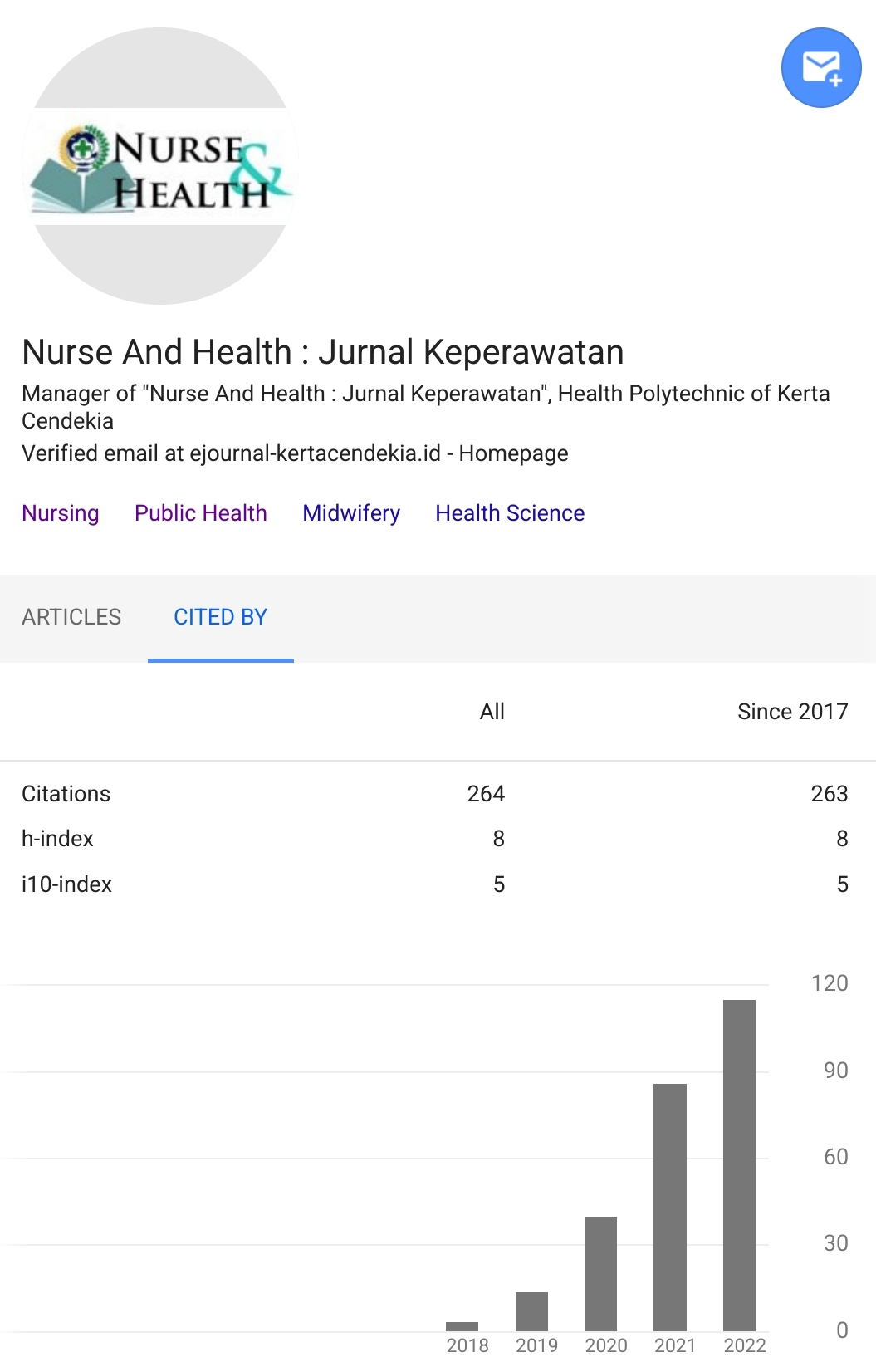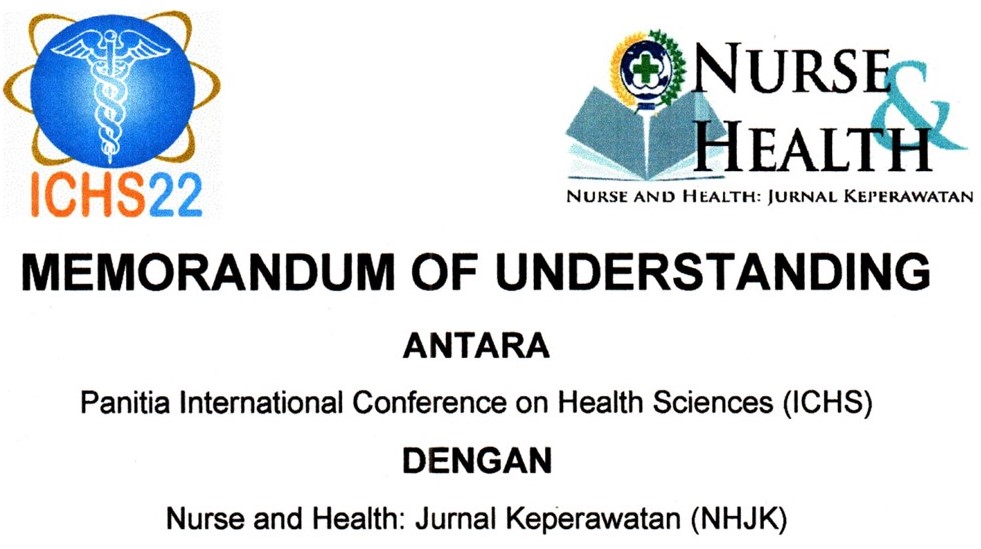AEROBIC AND ANAEROBIC EXERCISE TO ENHANCE PHYSICAL FITNESS OF CHRONIC KIDNEY DISEASE PATIENTS ON HEMODIALYSIS: A LITERATURE REVIEW
Abstract
Background: Chronic kidney disease is a condition where kidney has declining its function. It can cause a loss of physical capacity characterized by decreased body fitness, muscle strength and muscle endurance. Exercise programs to overcome the problem are still not common in dialysis clinics but there are several studies on exercise programs that have a positive effect on hemodialysis patients. Objectives: This study aimed to review aerobic and anaerobic exercise to enhance physical fitness for chronic kidney disease patients on hemodialysis. Design: The study design used was systematic review with using The Center for Review and Dissemination for writing guideline and the Joanna Briggs Institute Guideline for assessing the quality of summarized studies. Data Sources: Search for articles accessed through database, such as ProQuest, Scopus, Science Direct, SAGE, and PubMed with keywords: Chronic kidney disease, aerobic exercise, anaerobic exercise, physical function and hemodialysis. The literature was published 2015-2021. Review Methods: Joanna Briggs Institute Guidelines was used to assess the quality of the summarized studies. The presentation of the data will be done using descriptive techniques. Results: The result of this systematic review shows that both aerobic and anaerobic exercise have a significant result for chronic kidney disease patient who undergo hemodialysis therapy. But aerobic exercise had a long-term impact for patients than anaerobic exercise. Combination of aerobic (ergometer cycle) and anaerobic exercise (resistance training exercise) also show a significant effect for physical fitness. The mechanism for enhancing physical fitness is done by strengthen the body muscle. The side effect of exercise is found minimum in most of study. Conclusion: The combination of cycle ergometer exercise and resistance training exercise is one of the best exercises. The exercise could enhance the physical fitness by strengthen the muscle. The exercise could be done home based or intradialytic, but some articles state that intradialytic exercise is better than home based exercise.Downloads
References
Andre de Casto, A. P., Barboss, S. R., Mansur, H. N., Costa, M. B., & De Paula, R. B. (2018). Intradialytic resistance training: an effective and easy-to execute strategy. J Nephrol, 215–223. https://doi.org/10.1590/2175-8239-JBN-2018-0134
Bae, Y. H., Lee, S. M., & Jo, J. Il. (2015). Aerobic training during hemodialysis improves body composition, muscle function, physical performance, and quality of life in chronic kidney disease patients. Journal of Physical Therapy Science, 27(5), 1445–1449. https://doi.org/10.1589/jpts.27.1445
Bennett, P. N., Fraser, S., Barnard, R., Haines, T., Ockerby, C., Street, M., Wang, W. C., & Daly, R. (2016). Effects of an intradialytic resistance training programme on physical function: A prospective stepped-wedge randomized controlled trial. Nephrology Dialysis Transplantation, 31(8), 1302–1309. https://doi.org/10.1093/ndt/gfv416
Bohm, C., Stewart, K., Onyskie-Marcus, J., Esliger, D., Kriellaars, D., & Rigatto, C. (2014). Effects of intradialytic cycling compared with pedometry on physical function in chronic outpatient hemodialysis: a prospective randomized trial. Nephrology, Dialysis, Transplantation : Official Publication of the European Dialysis and Transplant Association - European Renal Association, 29(10), 1947–1955. https://doi.org/10.1093/ndt/gfu248
Chasani, S., & Hidayati, W. (2017). Studi fenomenologi: pengalaman aktivitas fisik klien yang menjalani hemodialisis. Jurnal Keperawatan Komprehensif, 8, 1–8.
Costa Rosa, C. D. S., Nishimoto, D. Y., E Souza, G. D., Ramirez, A. P., Carletti, C. O., Daibem, C. G. L., Sakkas, G. K., & Monteiro, H. L. (2018). Effect of continuous progressive resistance training during haemodialysis on body composition, physical function and quality of life in end-stage renal disease patients: a randomized controlled trial. Clinical Rehabilitation, 32(7). https://doi.org/10.1177/0269215518760696
Cristina, L., Lopes, C., Mota, F., Prestes, J., Schincaglia, R. M., Silva, M., Queiroz, N. P., Vaz, T., Freitas, D. S., & Lira, S. (2019). Intradialytic resistance training improves functional capacity and lean mass gain in hemodialysis patients : a randomized pilot trial Intradialytic Resistance Training Improves Functional Capacity and Lean Mass Gain in Individuals on Hemodialysis : A Rand. April 2020. https://doi.org/10.1016/j.apmr.2019.06.006
Fernandes, A. D. O., Sens, Y. A. D. S., Xavier, V. B., Miorin, L. A., & Alves, V. L. D. S. (2019). Functional and respiratory capacity of patients with chronic kidney disease undergoing cycle ergometer training during hemodialysis sessions: A randomized clinical trial. International Journal of Nephrology, 2019. https://doi.org/10.1155/2019/7857824
Frih, B., Jaafar, H., Mkacher, W., Salah, Z. Ben, Hammami, M., & Frih, A. (2017). The effect of interdialytic combined resistance and aerobic exercise training on health related outcomes in chronic hemodialysis patients: The Tunisian randomized controlled study. Frontiers in Physiology, 8(MAY), 1–11. https://doi.org/10.3389/fphys.2017.00288
Huang, M., Lv, A., Wang, J., Zhang, B., Xu, N., Zhai, Z., Gao, J., Wang, Y., & Li, T. (2020). The effect of intradialytic combined exercise on hemodialysis efficiency in end ‑ stage renal disease patients : a randomized ‑ controlled trial. International Urology and Nephrology, 0123456789. https://doi.org/10.1007/s11255-020-02459-1
Hughes, D. C., Ellefsen, S., & Baar, K. (2018). Adaptations to endurance and strength training. Cold Spring Harbor Perspectives in Medicine, 8(6), 1–17. https://doi.org/10.1101/cshperspect.a029769
Jamshidpour, B., Bahrpeyma, F., & Khatami, M. R. (2020). The effect of aerobic and resistance exercise training on the health related quality of life, physical function, and muscle strength among hemodialysis patients with Type 2 diabetes. Journal of Bodywork and Movement Therapies, 24(2), 98–103. https://doi.org/10.1016/j.jbmt.2019.10.003
KDIGO. (2013). KDIGO 2012 Clinical Practice Guideline for the Evaluation and Management of Chronic Kidney Disease. 3(1).
Kementrian Kesehatan Republik Indonesia. (2018). Laporan Nasional RISKESDAS 2018.
Lewis, R. (2012). Understanding Chronic Kidney Disease : a guide for the non-specialist. M&K Update Ltd, 2012.
Lok, C. E., Huber, T. S., Lee, T., Shenoy, S., Yevzlin, A. S., Abreo, K., Allon, M., Asif, A., Astor, B. C., Glickman, M. H., Graham, J., Moist, L. M., Rajan, D. K., Roberts, C., Vachharajani, T. J., & Valentini, R. P. (2020). KDOQI Clinical Practice Guideline for Vascular Access: 2019 Update. American Journal of Kidney Diseases, 75(4), S1–S164. https://doi.org/10.1053/j.ajkd.2019.12.001
Lopes, L. C. C., Mota, J. F., Prestes, J., Schincaglia, R. M., Silva, D. M., Queiroz, N. P., Freitas, A. T. V. de S., Lira, F. S., & Peixoto, M. do R. G. (2019). Intradialytic Resistance Training Improves Functional Capacity and Lean Mass Gain in Individuals on Hemodialysis: A Randomized Pilot Trial. Archives of Physical Medicine and Rehabilitation, 100(11), 2151–2158. https://doi.org/10.1016/j.apmr.2019.06.006
Nilsson, B. B., Bunæs-Næss, H., Edvardsen, E., & Stenehjem, A. E. (2019). High-intensity interval training in haemodialysis patients: A pilot randomised controlled trial. BMJ Open Sport and Exercise Medicine, 5(1). https://doi.org/10.1136/bmjsem-2019-000617
Ortega-Pérez de Villar, L., Martínez-Olmos, F. J., Pérez-Domínguez, F. de B., Benavent-Caballer, V., Montañez-Aguilera, F. J., Mercer, T., & Segura-Ortí, E. (2020). Comparison of intradialytic versus home-based exercise programs on physical functioning, physical activity level, adherence, and health-related quality of life: pilot study. Scientific Reports, 10(1), 1–10. https://doi.org/10.1038/s41598-020-64372-y
Rhee, S. Y., Song, J. K., Hong, S. C., Choi, J. W., Jeon, H. J., & Shin, D. H. (2019). Intradialytic exercise improves physical function and reduces intradialytic hypotension and depression in hemodialysis patients. Korean Journal Intern Med, 34, 588–598.
Rhee, S. Y., Song, J. K., Hong, S. C., Choi, J. W., Jeon, H. J., Shin, D. H., Ji, E. H., Choi, E. H., Lee, J., Kim, A., Choi, S. W., & Oh, J. (2019). Intradialytic exercise improves physical function and reduces intradialytic hypotension and depression in hemodialysis patients. Korean Journal of Internal Medicine, 34(3), 588–598. https://doi.org/10.3904/kjim.2017.020
Riebe, D., Ehrman, J. K., Liguori, G., & Magal, M. (2018). ACSM’s Guidelines for Exercise Testing and Prescription. Wolter Kluwer.
Scapini, K. B., Bohlke, M., Moraes, O. A., Rodrigues, C. G., Fs, J., Sbruzzi, G., Leguisamo, C. P., Sanches, I. C., Tourinho, H., & Irigoyen, M. C. (2019). Combined training is the most effective training modality to improve aerobic capacity and blood pressure control in people requiring haemodialysis for end-stage renal disease : systematic review and network meta-analysis. Journal of Physiotherapy, 65(1), 4–15. https://doi.org/10.1016/j.jphys.2018.11.008
Tao, X., Chow, S. K. Y., & Wong, F. K. Y. (2015). A nurse-led case management program on home exercise training for hemodialysis patients: A randomized controlled trial. International Journal of Nursing Studies, 52(6), 1029–1041. https://doi.org/10.1016/j.ijnurstu.2015.03.013
Valenzuela, P. L., de Alba, A., Pedrero-Chamizo, R., Morales, J. S., Cobo, F., Botella, A., González-Gross, M., Pérez, M., Lucia, A., & Marín-López, M. T. (2018). Intradialytic exercise: One size doesn’t fit all. Frontiers in Physiology, 9(JUL), 1–8. https://doi.org/10.3389/fphys.2018.00844
Wahid, A., Manek, N., Nichols, M., Kelly, P., Foster, C., Roberts, N., & Scarborough, P. (2016). Quantifying the Association Between Physical Activity and. https://doi.org/10.1161/JAHA.115.002495
Young, H. M. L., March, D. S., Highton, P. J., Graham-Brown, M. P. M., Churchward, D. C., Grantham, C., Goodliffe, S., Jones, W., Cheung, M. M., Greenwood, S. A., Eborall, H. C., Conroy, S., Singh, S. J., Smith, A. C., & Burton, J. O. (2020). Exercise for people living with frailty and receiving haemodialysis: A mixed-methods randomised controlled feasibility study. BMJ Open, 10(11). https://doi.org/10.1136/bmjopen-2020-041227
Copyright (c) 2022 Masita Widiyani, Tintin Sukartini, Abu Bakar

This work is licensed under a Creative Commons Attribution-NonCommercial 4.0 International License.
Authors who publish with Nurse and Health: Jurnal Keperawatan agree to the following terms:
- Authors retain copyright licensed under a Creative Commons Attribution-NonCommercial 4.0 (CC BY-NC 4.0), which allows others to remix, tweak, and build upon the authors' work non-commercially, and although the others' new works must also acknowledge the authors and be non-commercial, they don't have to license their derivative works on the same terms.
- Authors are permitted and encouraged to post their work online (e.g., in institutional repositories or on their website) prior to and during the submission process, as it can lead to productive exchanges, as well as earlier and greater citation of published work (See The Effect of Open Access). Authors can archive pre-print and post-print or publisher's version/PDF.








_resize1.jpg)















